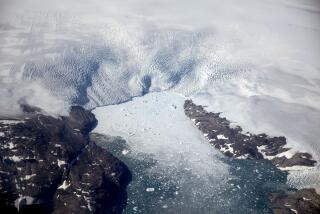Volcano Could Swamp Atlantic Coasts, Study Finds
A major landslide caused by a huge, lateral eruption of the Cumbre Vieja volcano in the Canary Islands could send out a tsunami and inundate Florida with 80-foot waves, a new study found. Indeed, many Atlantic Ocean coastlines could be hit--some by even higher waves.
Damage could run in the trillions of dollars in Florida, and the toll in human lives could be tremendous, said a paper by two scientists that appears in the September issue of Geophysical Research Letters.
The 80-foot waves could reach several miles into low-lying Florida.
But Steven N. Ward, a research geophysicist at UC Santa Cruz and one of the paper’s authors, pointed out that the interval between such monstrous tsunamis would be about 200,000 years. And a devastating tsunami from any oceanic volcano in the world might recur once every 10,000 years.
“We’re not trying to scare anybody,” Ward said in an interview Wednesday. “We don’t want to sell anybody’s real estate in Florida. On the other hand, these things do happen.”
There is geologic evidence of such occurrences in the past, said Ward and Simon Day, a geologist at University College in London.
The authors, noting there are likely to be volcanic warning signs before any landslide, urged that some planning be done.
Day said: “The [lateral] collapse will occur during some future eruption after days or weeks of precursory deformation and earthquakes. An effective earthquake monitoring system could provide advanced warning of a likely collapse and allow early emergency management organizations . . . time in which to plan and respond.”
But once it actually happened in, say, the Canaries, there would be little time to prepare. A tsunami is capable of moving at up to 500 miles an hour. It would take only eight to nine hours to reach Florida or other points on the East Coast.
Ward said the researchers chose the Cumbre Vieja volcano to study because there has been geological evidence of a likely future collapse.
With the most recent eruption of the volcano in 1949, a surface fault rupture appeared that could portend an eventual landslide, a lateral detachment of the kind that occurred in 1980 on Mt. St. Helens in Washington state.
Of course, Ward and Day said, there are various sizes of landslides, and it would take a worst-case scenario to send an 80-foot wave into the Florida coast.
Ward said the researchers based their scenario on a sudden displacement of about 100 cubic miles of rock. Tsunamis often are generated when such a displacement of earth propels a similar volume of water.
Ancient landslides off the north shore of Oahu in Hawaii have involved displacements 10 times larger, sending tsunamis across the Pacific. But a 100-cubic-mile displacement would still be nearly 1,000 times larger than the rock displaced in the Mt. St. Helens landslide, which pared the top 1,300 feet off that peak.
Ward said inspections of the Cumbre Vieja volcano indicate that 10 such landslides have occurred there in the last 2 million years.
More to Read
Sign up for Essential California
The most important California stories and recommendations in your inbox every morning.
You may occasionally receive promotional content from the Los Angeles Times.










